Auditing Theory and Practice: Dick Smith Case Study Report
VerifiedAdded on 2023/01/03
|6
|1127
|69
Report
AI Summary
This report provides an analysis of auditing theory and practice, using the case of Dick Smith as a central example. The report begins by examining the company's financial issues, including aggressive inventory purchases and a strained relationship with suppliers, which led to its insolvency. It explores the role of Deloitte, the auditing firm, and their opinions on the company's financial statements, particularly concerning the valuation of inventory and potential breaches of business protocols by the management. The report also discusses the four types of auditor's opinions and the legal liabilities of auditors, emphasizing the impact of audit opinions on stakeholders and capital raising. Overall, the report highlights the importance of proper auditing practices, accurate financial reporting, and effective inventory management in preventing corporate failures.
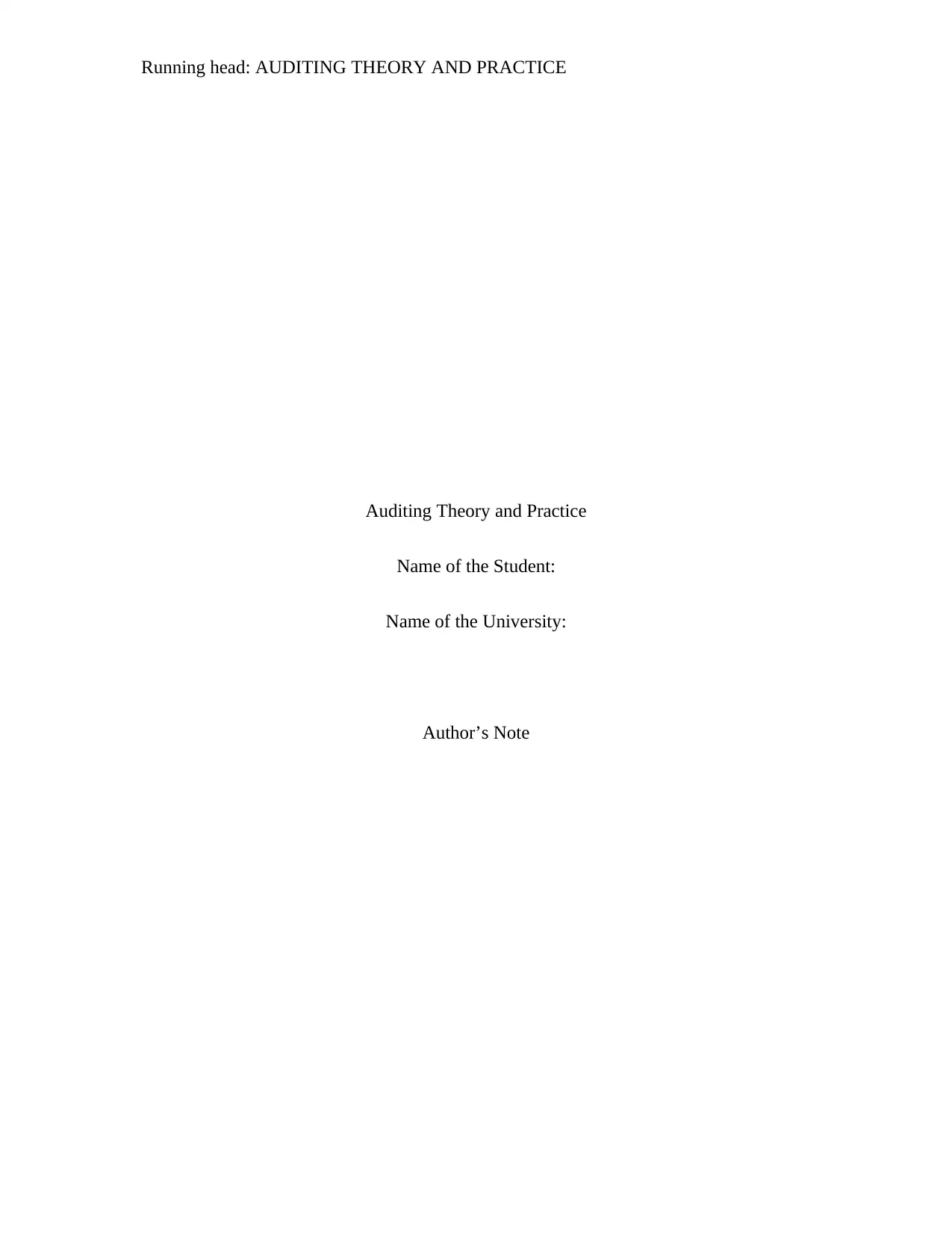
Running head: AUDITING THEORY AND PRACTICE
Auditing Theory and Practice
Name of the Student:
Name of the University:
Author’s Note
Auditing Theory and Practice
Name of the Student:
Name of the University:
Author’s Note
Paraphrase This Document
Need a fresh take? Get an instant paraphrase of this document with our AI Paraphraser
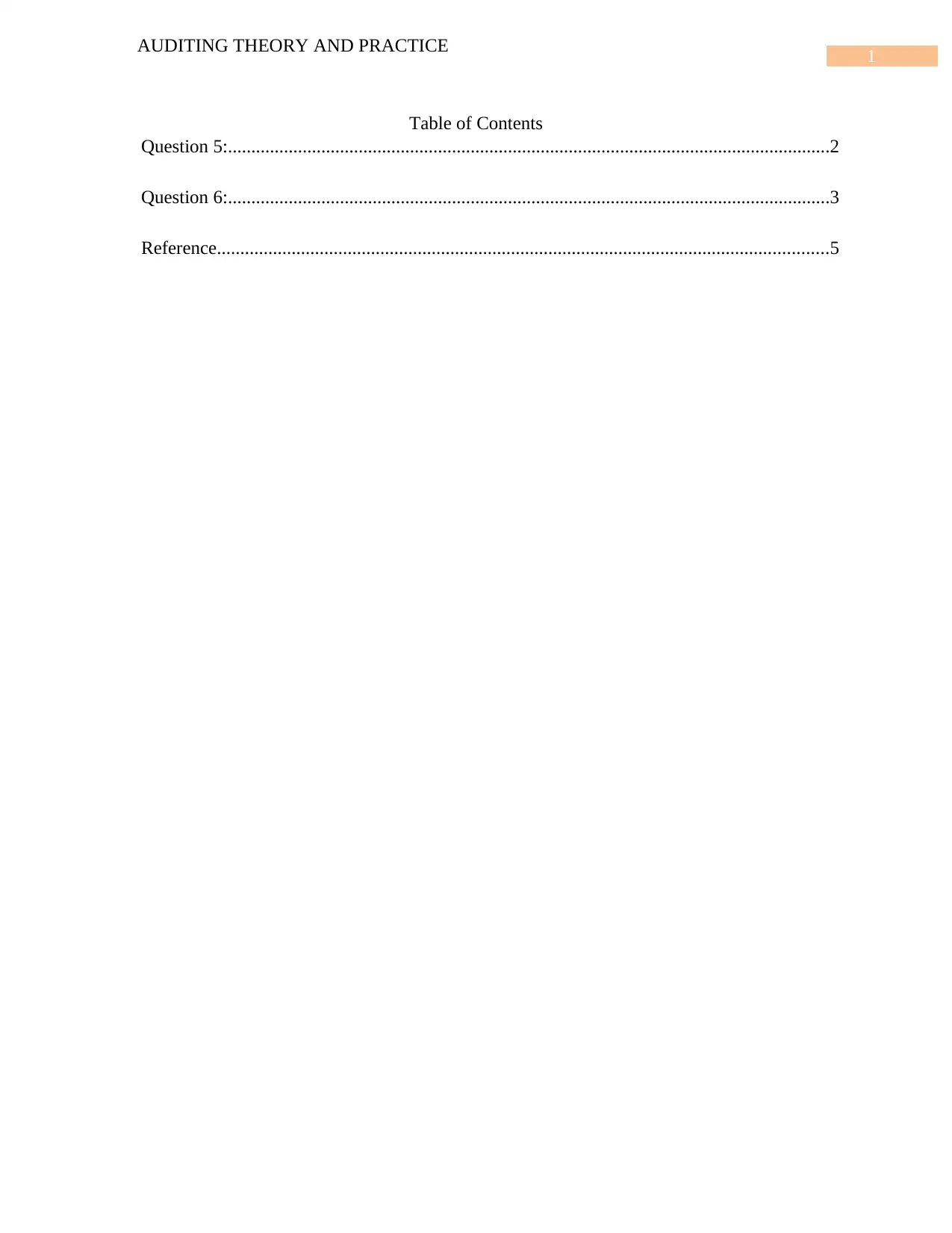
1
AUDITING THEORY AND PRACTICE
Table of Contents
Question 5:.................................................................................................................................2
Question 6:.................................................................................................................................3
Reference...................................................................................................................................5
AUDITING THEORY AND PRACTICE
Table of Contents
Question 5:.................................................................................................................................2
Question 6:.................................................................................................................................3
Reference...................................................................................................................................5
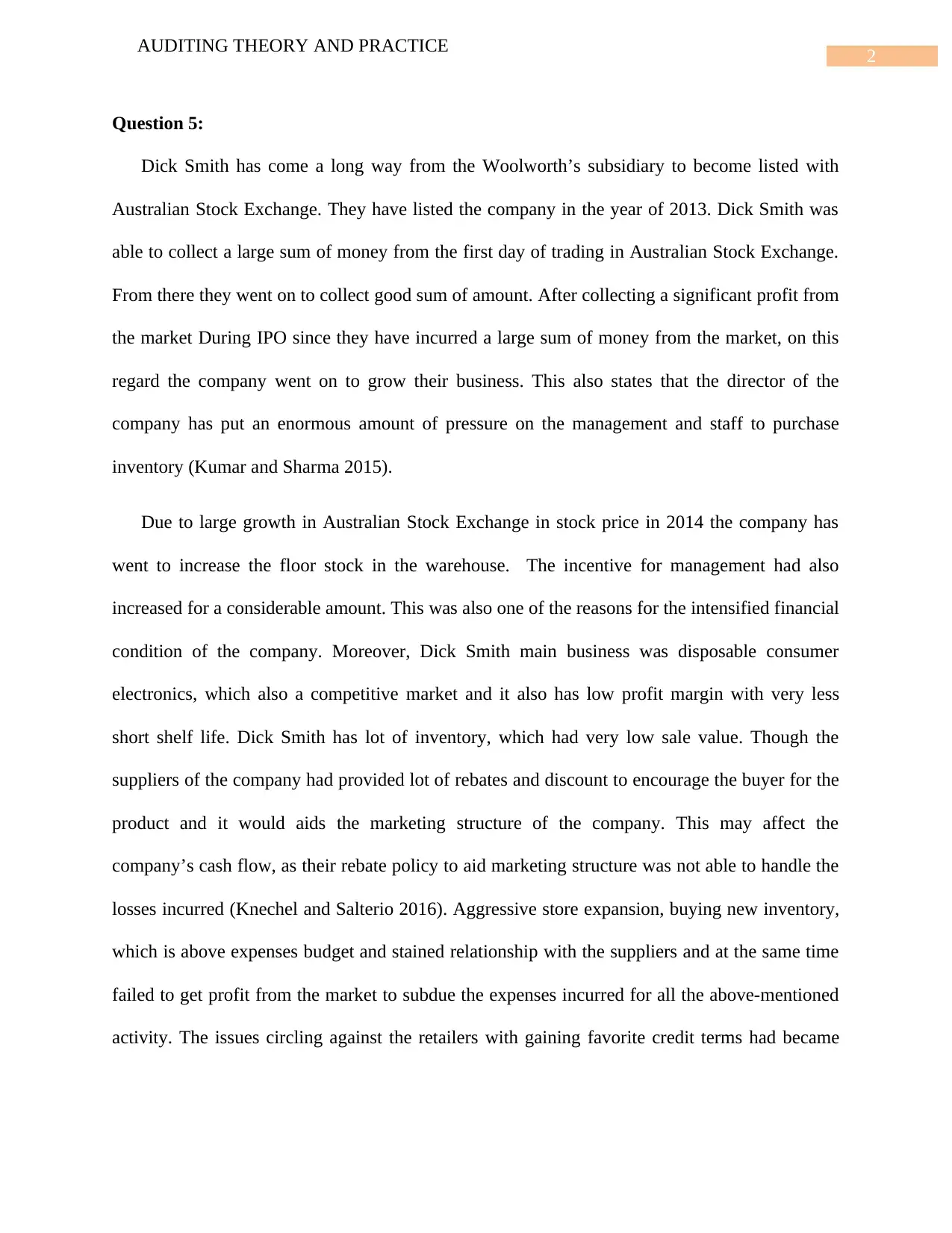
2
AUDITING THEORY AND PRACTICE
Question 5:
Dick Smith has come a long way from the Woolworth’s subsidiary to become listed with
Australian Stock Exchange. They have listed the company in the year of 2013. Dick Smith was
able to collect a large sum of money from the first day of trading in Australian Stock Exchange.
From there they went on to collect good sum of amount. After collecting a significant profit from
the market During IPO since they have incurred a large sum of money from the market, on this
regard the company went on to grow their business. This also states that the director of the
company has put an enormous amount of pressure on the management and staff to purchase
inventory (Kumar and Sharma 2015).
Due to large growth in Australian Stock Exchange in stock price in 2014 the company has
went to increase the floor stock in the warehouse. The incentive for management had also
increased for a considerable amount. This was also one of the reasons for the intensified financial
condition of the company. Moreover, Dick Smith main business was disposable consumer
electronics, which also a competitive market and it also has low profit margin with very less
short shelf life. Dick Smith has lot of inventory, which had very low sale value. Though the
suppliers of the company had provided lot of rebates and discount to encourage the buyer for the
product and it would aids the marketing structure of the company. This may affect the
company’s cash flow, as their rebate policy to aid marketing structure was not able to handle the
losses incurred (Knechel and Salterio 2016). Aggressive store expansion, buying new inventory,
which is above expenses budget and stained relationship with the suppliers and at the same time
failed to get profit from the market to subdue the expenses incurred for all the above-mentioned
activity. The issues circling against the retailers with gaining favorite credit terms had became
AUDITING THEORY AND PRACTICE
Question 5:
Dick Smith has come a long way from the Woolworth’s subsidiary to become listed with
Australian Stock Exchange. They have listed the company in the year of 2013. Dick Smith was
able to collect a large sum of money from the first day of trading in Australian Stock Exchange.
From there they went on to collect good sum of amount. After collecting a significant profit from
the market During IPO since they have incurred a large sum of money from the market, on this
regard the company went on to grow their business. This also states that the director of the
company has put an enormous amount of pressure on the management and staff to purchase
inventory (Kumar and Sharma 2015).
Due to large growth in Australian Stock Exchange in stock price in 2014 the company has
went to increase the floor stock in the warehouse. The incentive for management had also
increased for a considerable amount. This was also one of the reasons for the intensified financial
condition of the company. Moreover, Dick Smith main business was disposable consumer
electronics, which also a competitive market and it also has low profit margin with very less
short shelf life. Dick Smith has lot of inventory, which had very low sale value. Though the
suppliers of the company had provided lot of rebates and discount to encourage the buyer for the
product and it would aids the marketing structure of the company. This may affect the
company’s cash flow, as their rebate policy to aid marketing structure was not able to handle the
losses incurred (Knechel and Salterio 2016). Aggressive store expansion, buying new inventory,
which is above expenses budget and stained relationship with the suppliers and at the same time
failed to get profit from the market to subdue the expenses incurred for all the above-mentioned
activity. The issues circling against the retailers with gaining favorite credit terms had became
⊘ This is a preview!⊘
Do you want full access?
Subscribe today to unlock all pages.

Trusted by 1+ million students worldwide
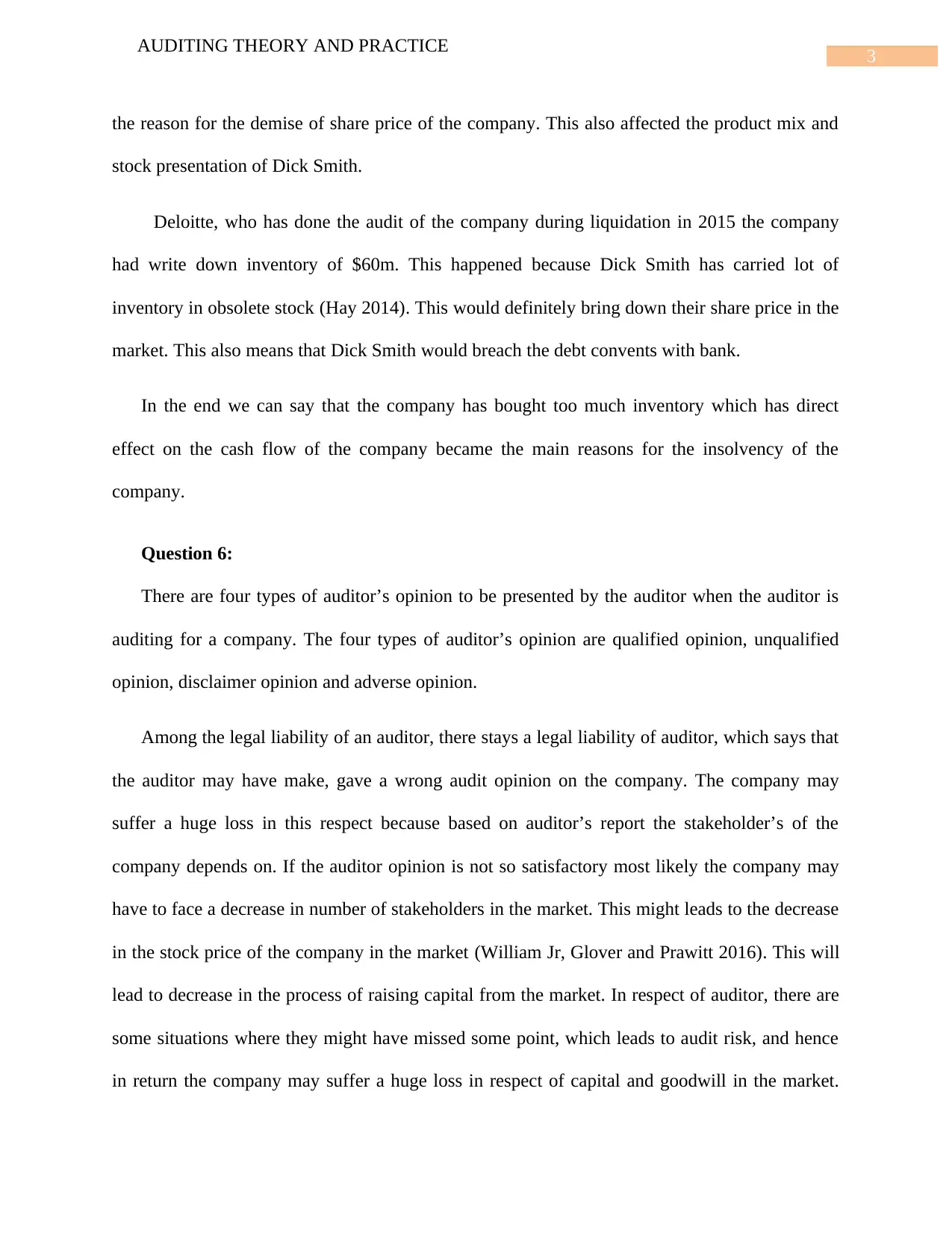
3
AUDITING THEORY AND PRACTICE
the reason for the demise of share price of the company. This also affected the product mix and
stock presentation of Dick Smith.
Deloitte, who has done the audit of the company during liquidation in 2015 the company
had write down inventory of $60m. This happened because Dick Smith has carried lot of
inventory in obsolete stock (Hay 2014). This would definitely bring down their share price in the
market. This also means that Dick Smith would breach the debt convents with bank.
In the end we can say that the company has bought too much inventory which has direct
effect on the cash flow of the company became the main reasons for the insolvency of the
company.
Question 6:
There are four types of auditor’s opinion to be presented by the auditor when the auditor is
auditing for a company. The four types of auditor’s opinion are qualified opinion, unqualified
opinion, disclaimer opinion and adverse opinion.
Among the legal liability of an auditor, there stays a legal liability of auditor, which says that
the auditor may have make, gave a wrong audit opinion on the company. The company may
suffer a huge loss in this respect because based on auditor’s report the stakeholder’s of the
company depends on. If the auditor opinion is not so satisfactory most likely the company may
have to face a decrease in number of stakeholders in the market. This might leads to the decrease
in the stock price of the company in the market (William Jr, Glover and Prawitt 2016). This will
lead to decrease in the process of raising capital from the market. In respect of auditor, there are
some situations where they might have missed some point, which leads to audit risk, and hence
in return the company may suffer a huge loss in respect of capital and goodwill in the market.
AUDITING THEORY AND PRACTICE
the reason for the demise of share price of the company. This also affected the product mix and
stock presentation of Dick Smith.
Deloitte, who has done the audit of the company during liquidation in 2015 the company
had write down inventory of $60m. This happened because Dick Smith has carried lot of
inventory in obsolete stock (Hay 2014). This would definitely bring down their share price in the
market. This also means that Dick Smith would breach the debt convents with bank.
In the end we can say that the company has bought too much inventory which has direct
effect on the cash flow of the company became the main reasons for the insolvency of the
company.
Question 6:
There are four types of auditor’s opinion to be presented by the auditor when the auditor is
auditing for a company. The four types of auditor’s opinion are qualified opinion, unqualified
opinion, disclaimer opinion and adverse opinion.
Among the legal liability of an auditor, there stays a legal liability of auditor, which says that
the auditor may have make, gave a wrong audit opinion on the company. The company may
suffer a huge loss in this respect because based on auditor’s report the stakeholder’s of the
company depends on. If the auditor opinion is not so satisfactory most likely the company may
have to face a decrease in number of stakeholders in the market. This might leads to the decrease
in the stock price of the company in the market (William Jr, Glover and Prawitt 2016). This will
lead to decrease in the process of raising capital from the market. In respect of auditor, there are
some situations where they might have missed some point, which leads to audit risk, and hence
in return the company may suffer a huge loss in respect of capital and goodwill in the market.
Paraphrase This Document
Need a fresh take? Get an instant paraphrase of this document with our AI Paraphraser
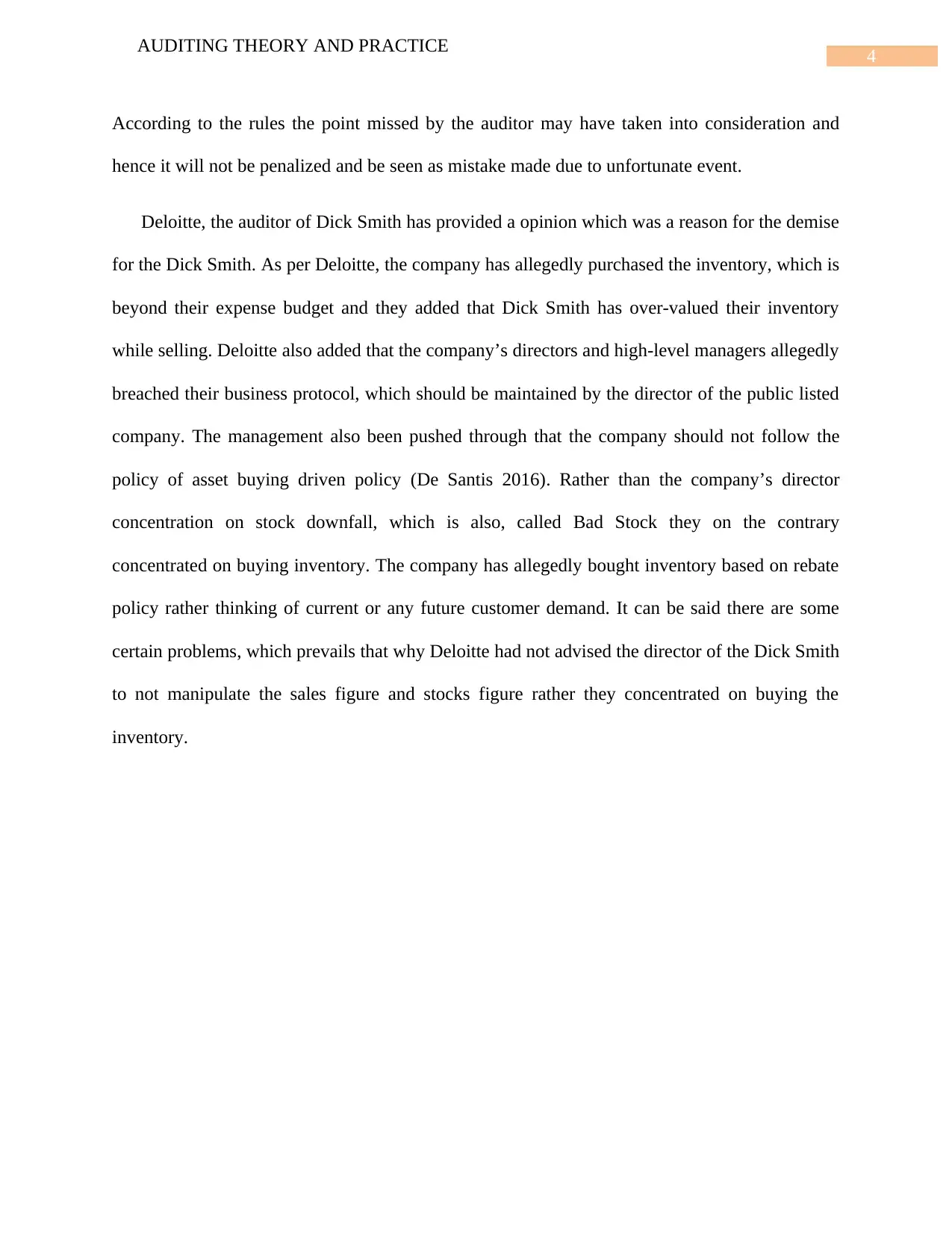
4
AUDITING THEORY AND PRACTICE
According to the rules the point missed by the auditor may have taken into consideration and
hence it will not be penalized and be seen as mistake made due to unfortunate event.
Deloitte, the auditor of Dick Smith has provided a opinion which was a reason for the demise
for the Dick Smith. As per Deloitte, the company has allegedly purchased the inventory, which is
beyond their expense budget and they added that Dick Smith has over-valued their inventory
while selling. Deloitte also added that the company’s directors and high-level managers allegedly
breached their business protocol, which should be maintained by the director of the public listed
company. The management also been pushed through that the company should not follow the
policy of asset buying driven policy (De Santis 2016). Rather than the company’s director
concentration on stock downfall, which is also, called Bad Stock they on the contrary
concentrated on buying inventory. The company has allegedly bought inventory based on rebate
policy rather thinking of current or any future customer demand. It can be said there are some
certain problems, which prevails that why Deloitte had not advised the director of the Dick Smith
to not manipulate the sales figure and stocks figure rather they concentrated on buying the
inventory.
AUDITING THEORY AND PRACTICE
According to the rules the point missed by the auditor may have taken into consideration and
hence it will not be penalized and be seen as mistake made due to unfortunate event.
Deloitte, the auditor of Dick Smith has provided a opinion which was a reason for the demise
for the Dick Smith. As per Deloitte, the company has allegedly purchased the inventory, which is
beyond their expense budget and they added that Dick Smith has over-valued their inventory
while selling. Deloitte also added that the company’s directors and high-level managers allegedly
breached their business protocol, which should be maintained by the director of the public listed
company. The management also been pushed through that the company should not follow the
policy of asset buying driven policy (De Santis 2016). Rather than the company’s director
concentration on stock downfall, which is also, called Bad Stock they on the contrary
concentrated on buying inventory. The company has allegedly bought inventory based on rebate
policy rather thinking of current or any future customer demand. It can be said there are some
certain problems, which prevails that why Deloitte had not advised the director of the Dick Smith
to not manipulate the sales figure and stocks figure rather they concentrated on buying the
inventory.
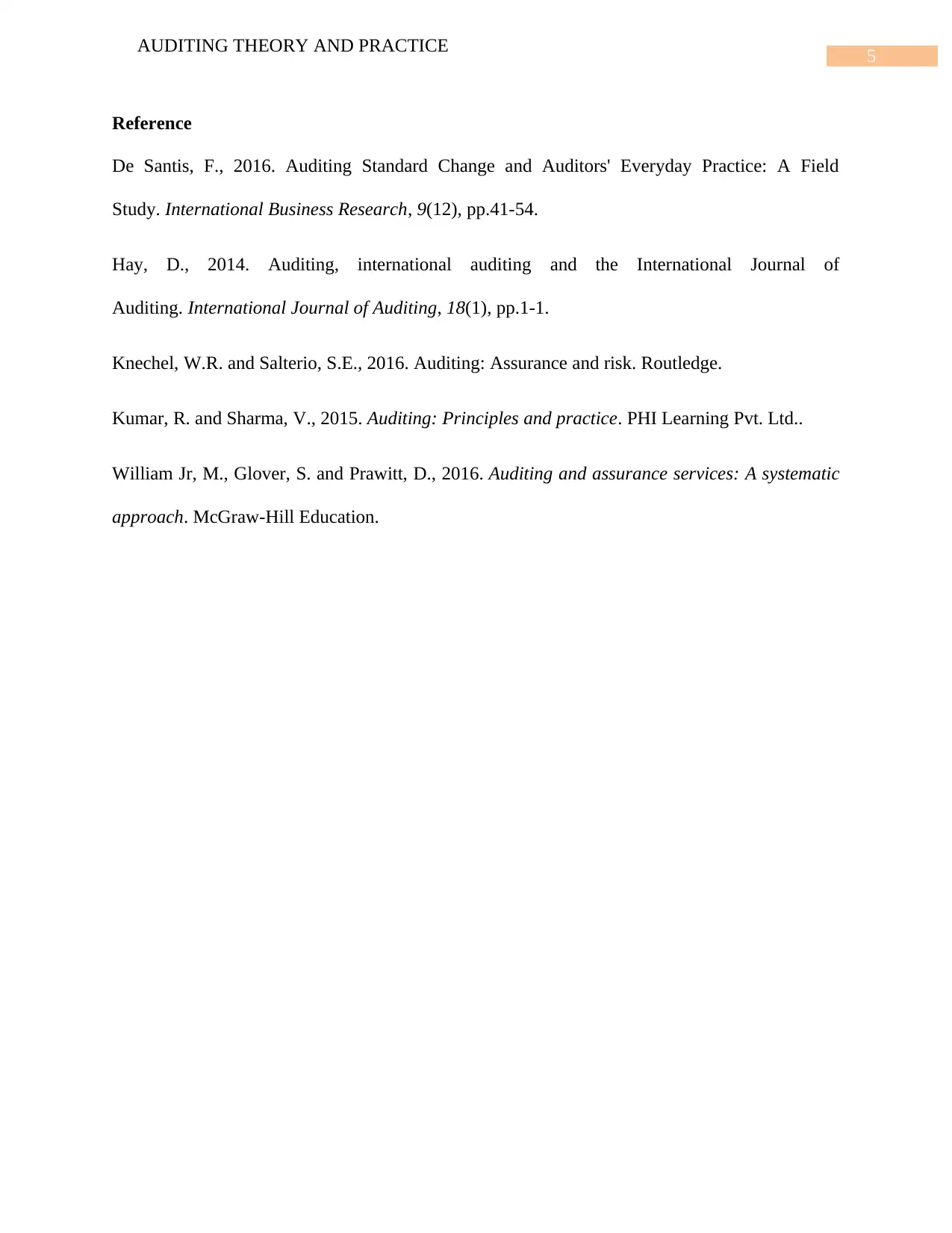
5
AUDITING THEORY AND PRACTICE
Reference
De Santis, F., 2016. Auditing Standard Change and Auditors' Everyday Practice: A Field
Study. International Business Research, 9(12), pp.41-54.
Hay, D., 2014. Auditing, international auditing and the International Journal of
Auditing. International Journal of Auditing, 18(1), pp.1-1.
Knechel, W.R. and Salterio, S.E., 2016. Auditing: Assurance and risk. Routledge.
Kumar, R. and Sharma, V., 2015. Auditing: Principles and practice. PHI Learning Pvt. Ltd..
William Jr, M., Glover, S. and Prawitt, D., 2016. Auditing and assurance services: A systematic
approach. McGraw-Hill Education.
AUDITING THEORY AND PRACTICE
Reference
De Santis, F., 2016. Auditing Standard Change and Auditors' Everyday Practice: A Field
Study. International Business Research, 9(12), pp.41-54.
Hay, D., 2014. Auditing, international auditing and the International Journal of
Auditing. International Journal of Auditing, 18(1), pp.1-1.
Knechel, W.R. and Salterio, S.E., 2016. Auditing: Assurance and risk. Routledge.
Kumar, R. and Sharma, V., 2015. Auditing: Principles and practice. PHI Learning Pvt. Ltd..
William Jr, M., Glover, S. and Prawitt, D., 2016. Auditing and assurance services: A systematic
approach. McGraw-Hill Education.
⊘ This is a preview!⊘
Do you want full access?
Subscribe today to unlock all pages.

Trusted by 1+ million students worldwide
1 out of 6
Related Documents
Your All-in-One AI-Powered Toolkit for Academic Success.
+13062052269
info@desklib.com
Available 24*7 on WhatsApp / Email
![[object Object]](/_next/static/media/star-bottom.7253800d.svg)
Unlock your academic potential
Copyright © 2020–2025 A2Z Services. All Rights Reserved. Developed and managed by ZUCOL.





